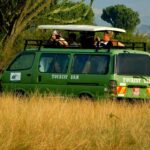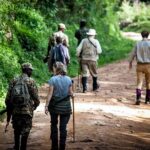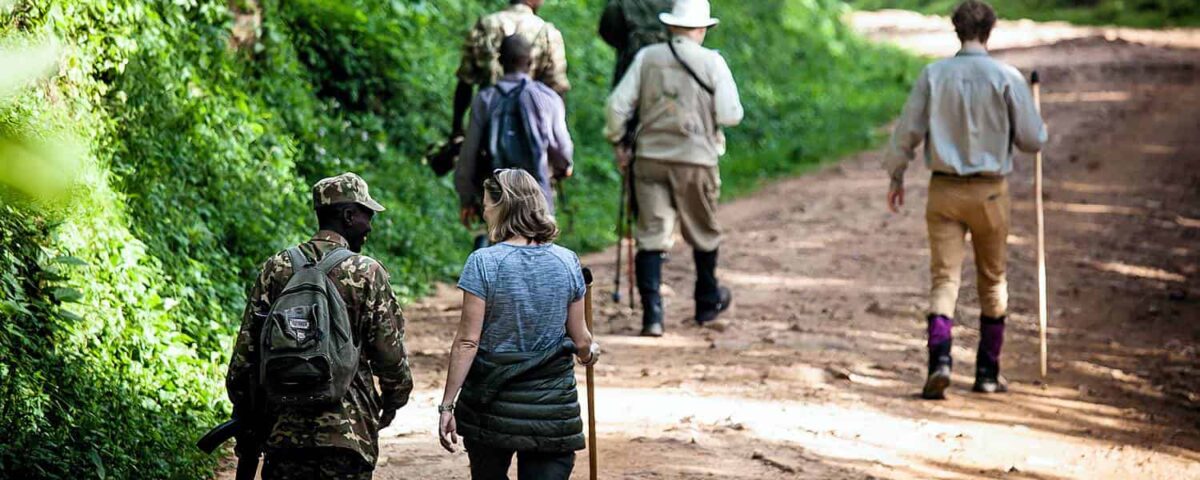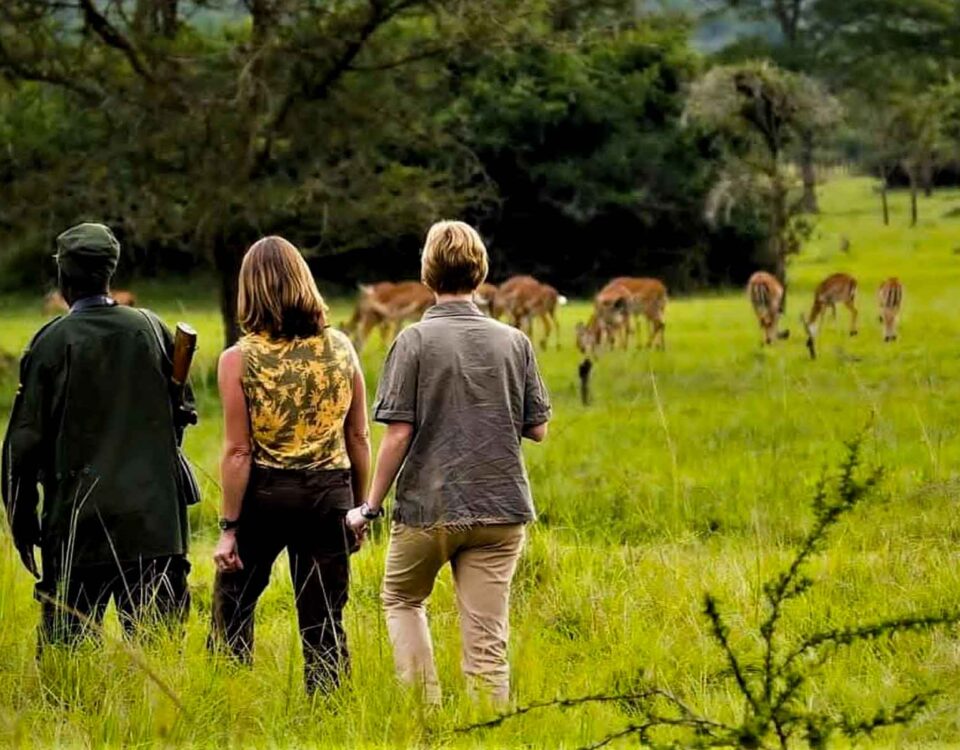
Are Park Entry Fees Included in the Game Drive Cost?
August 8, 2025
How Much Does a Walking Safari in Uganda Cost?
August 10, 2025Murchison Falls Tours: How do I book a walking safari in Uganda?
How do I book a walking safari in Uganda? This is a question that adventurous travelers often ask when planning a trip to East Africa’s hidden treasures. Walking safaris offer a completely different perspective compared to traditional vehicle-based wildlife safaris. They bring you closer to nature’s heartbeat, where the sounds of the bush replace the hum of an engine, and every footprint tells a story. Murchison Falls National Park, Uganda’s largest and most iconic protected area, is one of the best places in East Africa to embark on such an adventure.
Step into the Wild Heart of Africa
Spanning over 3,800 square kilometers, the park is a blend of savannah grasslands, woodland, riverine forests, and the dramatic Nile River, which roars through a narrow 7-meter gorge to form the legendary Murchison Falls. A walking safari here is led by trained Uganda Wildlife Authority (UWA) rangers or licensed local guides, ensuring both safety and an educational experience. These professionals share deep insights into wildlife behavior, tracking techniques, and the ecological significance of the area.
For travelers who have explored Kenya safaris across the Maasai Mara or Tanzania safaris in Serengeti, a walking safari in Murchison Falls offers an entirely fresh adventure. It can also be paired with Uganda gorilla trekking in Bwindi Impenetrable Forest, chimpanzee tracking in Kibale Forest, or even a Rwanda safari to Volcanoes National Park — giving you the chance to combine multiple world-class wildlife encounters in one unforgettable itinerary.
Why Choose a Walking Safari in Murchison Falls?
Murchison Falls Tours: How do I book a walking safari in Uganda if I want to truly immerse myself in the wilderness? The answer lies in understanding why this experience is unlike any other. Walking safaris strip away the barriers between you and the wild. You become part of the environment rather than an observer from afar. The crunch of dry grass beneath your boots, the scent of wild basil in the air, and the sight of giraffes at eye level create a sensory connection that is impossible to replicate from a safari vehicle.
Murchison Falls is home to over 76 mammal species, including elephants, buffaloes, lions, leopards, giraffes, and a variety of antelope. Birdwatchers will be equally captivated by the more than 450 bird species, among them the iconic shoebill stork, African fish eagle, and red-throated bee-eater. On a walking safari, you can focus on smaller but equally fascinating details — like insect behavior, medicinal plants, and the intricate tracks left by nocturnal animals.
Walking safaris are also a sustainable way to explore. They cause minimal disruption to wildlife, reduce carbon impact, and promote conservation awareness. Many travelers who have experienced Kenya safaris or Tanzania safaris say walking in Murchison Falls feels more personal and authentic. Better still, the park’s location allows you to combine this adventure with gorilla trekking or chimpanzee tracking, making it a key component of any complete Uganda safari.
Gorilla & Chimpanzee Trekking – Permits, Prices, and Booking
Murchison Falls Tours: How do I book a walking safari in Uganda and combine it with gorilla trekking or chimpanzee tracking? This is possible, and it adds extraordinary diversity to your trip. Uganda’s gorilla and chimpanzee trekking experiences are globally renowned, but they require permits.
Gorilla Trekking Permits:
- Foreign Non-Residents: USD 800 per person
- Foreign Residents: USD 700
- East African Citizens: UGX 300,000
Chimpanzee Tracking Permits:
- Foreign Non-Residents: USD 250 per person
- Foreign Residents: USD 200
- East African Citizens: UGX 150,000
Permits can be booked directly through the Uganda Wildlife Authority or via a licensed tour operator who will also arrange transport, accommodation, and logistics. These permits are limited in number and in high demand, so booking several months in advance is essential — especially if you want to coordinate them with a walking safari in Murchison Falls.
Age Limits: Gorilla trekking has a minimum age of 15 years, while chimpanzee tracking has a limit of 12 years. This ensures both visitor safety and minimal disturbance to the animals.
By combining your walking safari with gorilla trekking in Bwindi or chimpanzee tracking in Kibale or Budongo Forest, you’ll experience both the vast openness of the savannah and the dense mystery of Uganda’s tropical forests.
Best Time for Walking Safaris, Gorilla Trekking, and Chimpanzee Tracking
Murchison Falls Tours: How do I book a walking safari in Uganda at the best time of year? The timing is crucial for maximizing your experience. Uganda’s dry seasons, from June to September and December to February, are ideal for walking safaris, gorilla trekking, and chimpanzee tracking. Trails are less muddy, vegetation is thinner, and wildlife is more concentrated around water sources.
The wet seasons (March to May and October to November) have their own charm — lush green landscapes, fewer tourists, and potentially lower accommodation rates. However, trekking can be more physically demanding due to slippery conditions.
If you’re planning a multi-country trip that includes Kenya safaris for the Great Migration or Tanzania safaris in Serengeti, consider timing it so that your Uganda safari falls in the dry season. This ensures the best possible conditions for walking safaris and primate tracking.
What to Pack for Walking Safaris, Gorilla Trekking, and Chimpanzee Tracking
Murchison Falls Tours: How do I book a walking safari in Uganda and prepare for it? Packing correctly can make or break your adventure.
For Walking Safaris in Murchison Falls:
- Comfortable walking shoes or lightweight hiking boots
- Neutral-colored clothing to blend into the environment
- Wide-brim hat and sunglasses
- Binoculars for birdwatching
- Refillable water bottle
For Gorilla Trekking and Chimpanzee Tracking:
- Sturdy waterproof hiking boots with ankle support
- Long-sleeved shirts and trousers for insect and plant protection
- Lightweight rain jacket
- Gardening gloves for gripping vegetation
- Small backpack with water, snacks, and a camera
- Insect repellent and sunscreen
Well-prepared travelers enjoy their walking safaris and primate treks with more comfort, safety, and focus on the experience itself.
Cultural Experiences to Enrich Your Safari
Murchison Falls Tours: How do I book a walking safari in Uganda that also lets me experience local culture? The answer lies in integrating community visits into your itinerary. Around Murchison Falls, you can meet the Alur and Acholi communities, learning about their traditional dances, music, and craftsmanship. Village walks often include stops at local markets, where you can sample Ugandan dishes like matoke, groundnut sauce, or freshly caught Nile tilapia.
If you extend your journey to Bwindi for gorilla trekking, consider visiting the Batwa pygmies. These indigenous forest dwellers share stories of their hunter-gatherer lifestyle before gorilla conservation led to their resettlement. Such cultural experiences deepen your understanding of Uganda’s heritage and how conservation and community coexist.
Combining cultural tours with walking safaris creates a richer, more holistic adventure — one that travelers often find as memorable as their wildlife encounters.
Combining Walking Safaris with Other African Adventures
Murchison Falls Tours: How do I book a walking safari in Uganda and also explore other iconic African destinations? Uganda’s strategic location makes it easy to combine with neighboring countries. A traveler could start with a walking safari in Murchison Falls, continue to Bwindi for gorilla trekking, cross into Rwanda for a Volcanoes National Park safari, then fly to Kenya or Tanzania for the Great Migration.
This kind of multi-country itinerary showcases the full diversity of East Africa — from the open savannahs of Serengeti and Maasai Mara to the dense rainforests of Uganda and Rwanda. It appeals to travelers seeking the ultimate wildlife safari experience, blending big game encounters with intimate primate treks and cultural connections.


